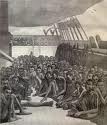2.1 Historical Overview of the Arrival of Africans to Cuba, 16th Century.

Upon the arrival of the Hispanics to America, there were already black slaves in Europe, brought there by traffickers of various nationalities such as Spanish and Portuguese.
At the beginning of colonization in Cuba, the indigenous people were forced to work as slaves in the search for gold and silver. As a result of the abuse and mistreatment they suffered, as well as epidemics such as smallpox and measles, the indigenous population was wiped out in a relatively short period of time. The extinction of the indigenous population favored the further expansion of the slave trade, which continued from the beginning of the conquest and prevailed until the first third of the 18th century in Cuba. The massive influx of Africans into our country began at the end of the 16th century.
Most African blacks were brought as slaves through the slave trade, the fundamental reason being economic, since the colonial industries established in the country required a large workforce.
Slaves were grouped into so-called councils, which prevented relations between the different African ethnic groups, with the aim of ensuring that each nation would preserve its original culture and thus avoiding possible mixing between them.
The African ethnic groups that populated the Cuban archipelago are made up of four main cultures: the Yoruba or Lucumí, the Congo or Bantu groups, the Carabalí culture, and the Arará culture. The cultures that most influenced the development of Cuban music were the Yoruba, the Bantu, and the Abakuá.
All music has a social significance; it acquires its timbres, rhythms, and melodies from society. Black Africans from diverse cultural groups greatly influenced and enriched Cuban music because this population constituted the basic stratum of our society for centuries.








